#studyace
Text
Unlocking the Past: Navigating World History Homework with Ease
World history serves as a captivating portal into the tapestry of human existence, weaving together stories of triumphs, failures, cultures, and innovations across the globe. However, for many students, the sheer expanse of historical events and intricacies can make homework assignments a daunting task. Yet, fear not! With a strategic approach and some helpful tips, diving into world history assignments can become an enjoyable and enlightening journey.
Understanding the Landscape
The first step in conquering world history homework is to comprehend the landscape. History isn’t just a sequence of dates and names but a narrative of events shaped by diverse cultures, socio-political dynamics, and technological advancements. Start by familiarizing yourself with the timelines, major civilizations, and pivotal moments. This helps in placing events in context and understanding their significance.
Effective Research Strategies
Research is the backbone of historical comprehension. When embarking on homework assignments, explore multiple sources to gain a holistic view. Reliable textbooks, scholarly articles, digital libraries, and reputable websites like academic journals and educational platforms provide a wealth of information. Verify facts across sources to ensure accuracy and depth in your understanding.
Cultivate Analytical Skills
History isn’t solely about memorizing facts; it’s about critical thinking and analysis. When tackling assignments, don’t just regurgitate information. Instead, analyze causes, effects, and implications of historical events. Consider different perspectives and interpretations, enabling you to form your own informed opinions.
Organizing Your Insights
Organizing information is pivotal to presenting coherent and structured assignments. Create outlines or mind maps to arrange key points, events, and connections between them. A clear structure not only helps in understanding but also assists in effectively conveying your ideas.
Embrace Technology as an Ally
In today’s digital age, technology offers a treasure trove of resources to aid in understanding history. Utilize educational apps, interactive websites, and online forums dedicated to history. These tools not only provide additional information but also offer engaging ways to learn, such as virtual tours of historical sites or interactive timelines.
Collaborative Learning
Engaging in discussions or study groups with peers fosters a deeper understanding of historical events. Explaining concepts to others not only solidifies your knowledge but also exposes you to different perspectives and interpretations.
Time Management
Effective time management is crucial. Break down tasks into smaller, manageable chunks, and allocate time for research, analysis, and writing. This not only prevents last-minute rushes but also allows for a thorough understanding of the subject matter.
Seeking Assistance
Remember, it’s absolutely okay to seek help when needed. Teachers, tutors, or online educational platforms can provide guidance and clarification on complex topics. Don’t hesitate to ask questions; it’s a sign of curiosity and eagerness to learn.
Navigating world history homework need not be a daunting expedition. By understanding the terrain, employing effective research and analytical skills, organizing insights, leveraging technology, collaborating with peers, managing time efficiently, and seeking guidance when required, students can not only conquer their assignments but also develop a profound appreciation for the rich tapestry of human history.
Embrace the journey through time and let the stories of our past enrich your present understanding of the world!
For more info. :-
Homework Help World History
Studyacer
0 notes
Text
studyace replied to your post “Rules: choose 10 different fandoms and pinpoint your favorite...”
**Oh oops this was ange's other main pls ignore this
YOUVE BEEN EXPOSED.........
2 notes
·
View notes
Photo

#booklover beacauseofreading booknerd bookish booklovers studystudystudy studyinspiration kawaii kawaiistationery studyspo studyac#beacauseofreading#booknerd#bookish#booklovers#studystudystudy#studyinspiration#kawaii#kawaiistationery#studyspo#studyaccount
2 notes
·
View notes
Audio
StudyAcer is a leading and the best homework help service provider for students. StudyAcer writers offer top assignment writing service to students.
Study Acer
1 note
·
View note
Photo

theme 04: persimmon by studyace
preview
code, alternate
contact me
features colorful gradients. sidebar image is 60px. options include 700/500/400/250px posts (250 can be 1 or 2 columns), up to 6 links (make sure to select the number in the dropdown menu), social media, and search.
#themes#codes#themegalore#codingcabin#themehive#mine#and this time it's named for 'persimmons' by li young lee#the blog title is from his poem 'blossom'
576 notes
·
View notes
Photo

#redepic #allhands #hmi video production san francisco capitola media los angeles #4K #silk #setup #directorofphotography #commercial #videosquad #bayarea #camerasready #losangeles #siliconvalley #agency #marketing #advertising #filmcrew #rehearsalsup @study.ace #focus #videoproduction #talent #actor actors #btsvideo #sfbay #studyace #client #filmgear @capitolamedia 🎥🎬🌉 (at Capitola Media LLC)
#advertising#filmgear#rehearsalsup#silk#allhands#studyace#hmi#filmcrew#focus#losangeles#bayarea#btsvideo#videoproduction#siliconvalley#client#redepic#camerasready#talent#commercial#agency#4k#marketing#actor#sfbay#setup#videosquad#directorofphotography
0 notes
Note
congrats on 100 followers! :) today i reread a poetry collection that i really like and had lemon tea at starbucks which was pretty nice
URL: don’t get it sorry | it’s kinda cute actually | amazing! | wowowow | how did you get this who did you kill?
ICON: ngl kinda basic | meh cute i guess? | v nice | lovelovelove | okay i’m stealing it!!
DESKTOP THEME: default | i’m confused? | not bad | how is this so cute?! | aaah I love and might accidentally steal the code oops!!
MOBILE THEME: default | i’m confused? | not bad | how is this is so cute?! | aaah I love and might accidentally steal the code oops!!
ORIGINAL CONTENT: couldn’t find any | you’re getting there | so pretty?! | aesthetic af | amazing i’m reblogging everything!!
OVERALL: 1 | 2 | 3 | 4 | 5 | 6 | 7 | 8 | 9 | 10 | out of this world
FOLLOWING: no, sorry! | i am now! | yes | duh ofc
WANT A BLOG RATE?
0 notes
Photo

#sailing #sailingteam #scholarathlete #studyace flashcard maker #sail #ncaa #boston #mitboathouse #recruitment #officialletter #scholarship -- Available in the App Store. // Top schools. Ace your games, Ace your test . . . . @study.ace StudyAce fast simple beyond flashcards #studytools #learninggames #test #testprep #homework online learning tools #studygames memorization physicalsciences apbio top apphysics school #flashcards maker #studyprep studypreparation #highschool college sats apexam #gaming #flashcard #maker apexams actexam psat vocabulary verbal #games prealgebra biology #class #math greexam apclass lsat community apclasses learn learning online #quiz #education iOS Android PC success share #mobile anytime anywhere go fast #varsityletter (at StudyAce)
#mitboathouse#games#studytools#class#ncaa#learninggames#education#studyace#flashcard#varsityletter#testprep#officialletter#mobile#maker#studygames#quiz#test#sailingteam#gaming#homework#recruitment#scholarship#studyprep#sailing#highschool#sail#scholarathlete#flashcards#boston#math
0 notes
Text
tag 9 people you want to get to know better
tagged by the lovely @codematurgy :)
Favorite Color: purple :)
Top 3 favorite ships: hmmm definitely amy and jake from b99, pepper and tony from marvel and eleanor and chidi from the good place!
Lipstick or Chapstick: chapstick but i hardly use it so lipstick more asdfg
Last Song: him and I
Last Movie: Jurassic World: Fallen Kingdom last night asdfg (damn jeff goldblum looked good)
Currently Reading: i finished reading the kite runner for the 10000th time yesterday and am reading a thousand splendid suns
I am tagging some people from codingcabin hope you dont mind! @annasthms @cactusthemes @sorrism @grangersdesigns @mistletoe @clerihew @skyofrp @solarre and @studyace
1 note
·
View note
Text
9 people you’d like to know better.
Rules: Tag 9 people you’d like to get to know better
Tagged by: @nonspace and @fukuo! thanks for tagging me!!
Tagging: @gukthemes @clerihew @amaanat @silbrigthemes @kuzuriha @studyace @octomoosey @linthm and any other theme maker really because i have an awful memory ahaha
Favorite Color: yellow!
Top 3 favorite ships: uuuuh i've been thinking about this for a whole day and have no idea so i'll just say my three favorite from league of legends. it's vikjayce, tobias/graves and garen/darius! honestly sorry for the lack of gals on top
Lipstick or Chapstick: 99% of the time i don't use anything but i only own lipstick so lipstick
Last Song: i honestly have no idea but considering my spotify is currently on random at the songs of faith and devotion album i will say depeche mode - mercy in you
Last Movie: how to train your dragon 3! i didn't see the second movie though but i recently saw the first one on tv with my mom and cried
Currently Reading: i want to get back to my reading habits but at the moment i'm just reading viktor frankl's search for meaning book for college. i did stop midway through the second book of percy jackson part 2 by rick riordan though
#code blogging#i am amazed that i manage to be talkative at even the simplest questions#i tried to not repeat users but i might have. failed.
1 note
·
View note
Photo
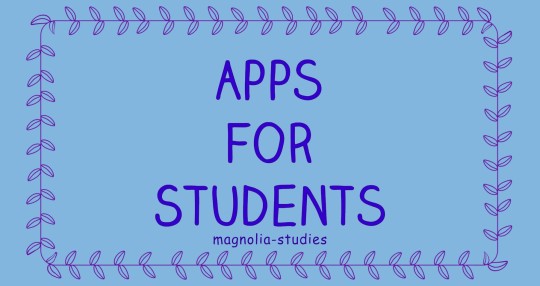
Saturday, July 22nd, 2017
Here are some of the very best apps for students; either in highschool or in college. I have used many of the following apps, but not all of them. Some, I have just asked friends about and they suggested those ones.
Please enjoy the apps below, tell me how you like them, and feel free to add onto this list :)
Focus: SelfControl, Forest, MindNode, FocusBooster, FocusWriter, Think, StayFocused, Freedom, Cold Turkey, Anti-Social, Time Out, SmartBreak, Balanced
Productivity: Evernote, Any.do, MyScript Nebo, Outlook, Trello, Droptask, Basecamp, Pocket, Gyst, Doodle, Pen and Paper, Wunderlist, Toggl, Asana, Wolfram Alpha
Sounds: Tide, WhiteNoise, Chroma Doze, Coffitivity, Noisli, Brain.fm, NatureSpace, Noizio, Rainy Mood, SimplyNoise, Spotify, Slacker Radio
Language Learning: Duolingo, Memrise, Busuu, Babbel, Livemocha, Living Language, Tandem, MindSnacks
Games: Lumosity, Sudoku, TanZen, GeoMaster Plus HD, Speed Anatomy, Star Walk, LeafSnap, Splice: Tree of Life, Vismory, Pigments, Viridi, Sunshine, Nota
Revision: Gojimo, Revision App, iMindMap, Exam Countdown, Penultimate, Clippet
Test Prep: Khan Academy, Magoosh ACT Flashcards, The Grading Game, Math Brain Booster, ACCUPLACER Study App, CK-12, NRICH, StudySync, Quizlet, StudyAce, That Quiz, Brilliant, Synap
Planner: Timeful, Remember the Milk, Listastic, Finish, 2Do, iStudiez Pro, MyHomework Student Planner, My Study Life, ClassManager, MyLifeOrganized, Daily Agenda, Schedule Planner, Todoist
Writing: EasyBib, ProWritingAid, Bubbl.us, WiseMapping, yWriter5, Storybook, Q10, Write 2 Lite, Writer, Diaro, Note Everything, OmmWriter, Draft
Health: MyFitnessPal, Lose It, Endomondo, FitNet, Sworkit, Daily Yoga, Yonder, Fooducate, SideChef, Rise, LifeSum, Meditation Studio, Happify, 7 Cups, Clue, Start, Power Nap App, Fit Radio, Calm
Courses: Corsera, PhotoMath, Udemy, HowCast, SimpleMind+, Open Culture, Canvas, Schoology, Alison, CourseBuffet, Degreed, Instructables, InstaNerd, Big Think, Yousician, Pianu
Books & Reading: CampusBooks, Scribd, Pocket, Wattpad, GoodReads, Readmill, Audible, Prizmo, Blio, Kindle, Overdrive, BlueFire Reader, Nook, Kobo, Aldiko, Cool Reader
Note Taking: SuperNotes, StudyBlue, Bento, QuickOffice, Google Keep, Zoho Notebook, Simplenote, Bear, OneNote, Box Notes, Dynalist.io, Squid, Notability
Inspiration: TED, Lift, Believe It: You Will Achieve, BrainCourage, Get Inspired, iFundamentals, Reinventing Yourself, iWish, Pozify, Positive Thinking - The Key to Happiness, The Gratitude Journal
Other: WiFi Finder, Mint, Zwoor, Brain Pump, Curiosity, Ready4 SAT, GradeProof, edX, Mendeley, Due, CamScanner, IFTTT, Square Cash
#studyblr#apps#students#college#highschool#school help#school apps#education#studyspo#study help#studies#studying#study#school#notes#note taking#planner#inspiration#books#reading#classes#writing#health#test prep#revision#games#language learning#sounds#productivity#focus
29K notes
·
View notes
Text
Navigating the Benefits and Ethical Considerations of Professional Academic Writing Services
In today's academic landscape, the demands placed on students are immense. Juggling multiple assignments, extracurricular activities, part-time jobs, and personal commitments often leaves students overwhelmed and pressed for time. Consequently, the use of professional academic writing services has become a controversial yet prevalent practice.
These services, offered by various online platforms, promise to assist students in producing high-quality essays, research papers, theses, and other academic assignments. While some advocate for their convenience and efficacy, others raise ethical concerns regarding their use.
The Upsides of Professional Academic Writing Services
Expertise and Quality Assurance: These services often employ professionals with advanced degrees in diverse fields. Their expertise ensures the delivery of well-researched, structured, and meticulously written papers that meet academic standards.
Time Management: Students grappling with time constraints find relief in outsourcing some of their academic work. This allows them to focus on other crucial aspects of their education without compromising quality.
Learning Opportunities: Engaging with such services can serve as a learning aid. By studying the delivered work, students can grasp complex concepts, enhance their writing skills, and understand how to structure their own papers effectively.
Meeting Deadlines: With looming deadlines, these services provide a safety net, ensuring assignments are submitted on time and reducing academic pressure.
Ethical Concerns and Caveats
Academic Integrity: Critics argue that using these services undermines the fundamental principles of education, such as honesty and personal effort. Submitting work that isn't one's own misrepresents the student's abilities and knowledge.
Risk of Plagiarism: There's a risk of potential plagiarism if students fail to properly attribute the outsourced content or if the service delivers plagiarized material. This can lead to severe consequences, including academic penalties.
Dependency: Over-reliance on these services can inhibit students' critical thinking, research, and writing skills, which are integral to their academic and professional growth.
Navigating the Ethical Dilemma
Transparency: Institutions and educators must foster open discussions about the use of such services, emphasizing the importance of academic integrity while acknowledging the challenges students face.
Guidance and Support: Providing academic support, resources, and guidance can alleviate the pressure on students and reduce the temptation to resort to these services.
Use as a Learning Aid: Encouraging students to utilize these services as supplementary learning tools rather than as a means to bypass academic responsibilities can promote responsible usage.
ᅠprofessional academic writing services offer both advantages and ethical dilemmas. While they can provide temporary relief and support, their use should be approached cautiously, with a focus on maintaining academic integrity and fostering genuine learning experiences. By addressing the root causes of academic stress and providing adequate support, institutions can help students navigate the challenges they face without compromising their academic integrity.
For more info. :-
Professional Academic Writing Services
Studyacer
1 note
·
View note
Text
hi!
wake up: 9:30
bedtime: 12:00
today i
repotted my plants
did one transcription
sent some necessary communications
i’ve also been thinking a lot about my relationship with the studyblr community, and i think i’ve mostly just existed on the periphery of it. i kind of went through cycles of activity and inactivity. as i was going through a lot of studyblr stuff, trying to form a direction for my summer, i was surprised by how much i missed it. i think i do want to be a part of the community, fully, as an element of my goal of acquiring some discipline this summer. seeing the productive lifestyle on other people’s blogs that i completely neglected this school year was really motivating.
so i’m making a tiny re-introduction:
hi, i’m ace, they/them. i’ll be a sophomore in college next year and i’m majoring in linguistics and possibly psychology. my tentative future plans are to attend graduate school to pursue research in second language acquisition and pedagogy. i also love history and historical linguistics, especially medieval and early modern england. much ado about nothing is my favorite play, closely followed by othello (idk what my favorite book is so i’m saying plays instead).
i’m tagging some mutuals, just to say hi! my blog is usually ded and shouting into the void is kinda awkward sometimes! feel free to ignore this, i’m kinda putting you on the spot, but also if you ever want to chat/tag me in stuff/swap study and life tips/need advice, etc, you can drop me a line!
(also if you see this and i didn’t tag you, you can still take me up on any of the above!)
@academicnerd @acxaii-study @hollohat @huacademic @kataopiskelee @leafystvdies @learninqs @malias @second-thirteen @soft-artt @study-and-dream @studyace @studyeliza @teawithstress
3/80
#ace notes#all mirth and no matter#gallants of the town#challenged him at the bird bolt#80 days of productivity
6 notes
·
View notes
Text
Let’s Get Scientific: Ecosystems & Biodiversity
Environmental studies cannot be discussed without mention of science. Natural sciences and the scientists that study them are fundamental to understanding how our environment works, how we come to understand the way it works, and how we are affecting it.
In chapters 2 and 3 of Living in the Environment, Miller covers the basics of natural sciences like chemistry, biology, and physics, as they apply to environmental studies. As a chemistry major, most of the information was review, but in order to have a comprehensive understanding of environmental studies the information is critical. Scientists study the natural world through field and laboratory research. Field research allows first-hand observation of forests, oceans, and mountains, examining the extremely complex ecosystems that exist and collecting data that aids humans in interacting with said ecosystems. Laboratory research involves the development of systems that mimic natural ones, and are helpful because they allow for better control of variables.
Some scientific principles, like the law of conservation of energy, help describe why some human behaviors are so harmful to the environment. Energy is divided into two categories: renewable and nonrenewable. Renewable sources of energy, like solar power, wind, moving water, wind, and geothermal energy are replenishable through natural processes. Nonrenewable sources of energy are not replenishable through natural processes on a human time scale, these include oil, coal, natural gas, and nuclear energy. Commercial energy is the 1% of energy that does not come from the sun. The burning of fossil fuels makes up 90% of it.
There are four main systems of earth’s life support system: the atmosphere, hydrosphere, geosphere, and biosphere. The atmosphere contains ozone that filters out 95% of UV radiation, and other gasses that help keep the earth warm by trapping heat from the sun. Oceans contain 97% of earth’s water and an enormous amount of biodiversity. The geosphere contains fossil fuels and minerals that are used by humans and other species regularly. Finally, the biosphere is where we live, along with all other life forms.
An important part of the way the world operates is how organisms interact with each other. Organisms are either producers (who make their own nutrients from the environment), consumers (who feed on other organisms for nutrients), or decomposers (who transform waste into nutrients). Ecosystems are sustained through the one-way energy flow (solar energy) and nutrient cycling that happens through these three groups of organisms. Two key indicators are GPP (gross primary productivity) and NPP (net primary productivity). GPP is the rate that energy is converted from solar to chemical by producers and stored in compounds, and NPP is the rate that producers use photosynthesis to produce chemical energy minus the rate they use the stored energy in aerobic respiration.

Figure 1. Indicators of productivity. (“How does gross primary productivity differ from net primary productivity?” Socratic Q&A Biology. November 3, 2015. Accessed February 2, 2020.https://socratic.org/questions/how-does-gross-primary-productivity-differ-from-net-primary-productivity)
There are numerous other natural cycles that sustain life on earth, including the water cycle, carbon cycle, nitrogen cycle, and phosphorous cycle. I find cycles to be best understood through diagrams, so below are some helpful graphics.
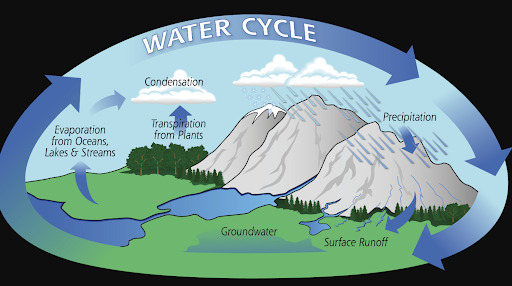
Figure 2. The Water Cycle. (“The Water Cycle.” NASA. Accessed February 2, 2020. https://pmm.nasa.gov/education/water-cycle)

Figure 3. The Carbon Cycle. (“The Carbon Cycle.” UCAR Center for Science Education. Accessed February 2, 2020. https://scied.ucar.edu/carbon-cycle)

Figure 4. The Nitrogen Cycle. (“Nitrogen Cycle.” studyACS. December 21, 2017. Accessed February 2, 2020. https://www.studyacs.com/blog-nitrogen-cycle-37.aspx)
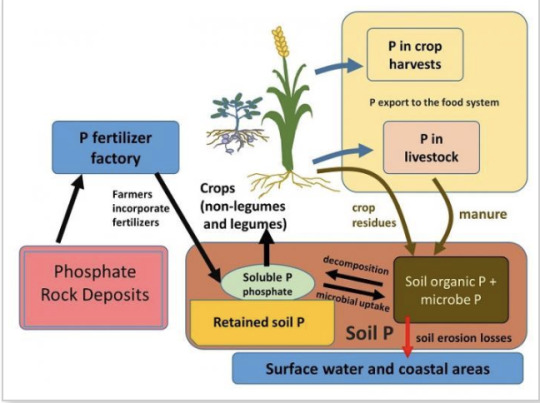
Figure 5. The Phosphorus Cycle. (“The Phosphorus Cycle and Human Management of Soils.” InTeGrate. January 11, 2018. Accessed February 2, 2020. https://serc.carleton.edu/integrate/teaching_materials/food_supply/student_materials/1176)
Chapter four examines the importance of biodiversity, “the variety of life on earth” [1]. There are four components to biodiversity, species diversity, genetic diversity, ecosystem diversity, and functional diversity. Species diversity deals not only with the number of different species in an ecosystem (richness) but also their comparative abundance (evenness). Genetic diversity is the variety of different genes in a species. Ecosystem diversity refers to the presence of many different biological communities, such as deserts, oceans, mountains, and forests. Functional diversity is the variety of natural processes within ecosystems.
Within an ecosystem, species play different roles, termed their “ecological niche,” which can be either broad (for generalists) or narrow (for specialists). Species are classified as native, nonnative, indicator, or keystone to an ecosystem. While definitions of native and nonnative are rather straightforward, indicator species warn of changes in environmental conditions, and keystone species are those that are fundamental to the ecosystem--without them, there is a great risk of collapse.
Earth’s biodiversity is ultimately determined by the balance between speciation (formation of new species) and extinction which are entirely dependent on our changing environmental conditions.
Chapter five discusses how species interact, including predator-prey relationships, parasitism, mutualism, and commensalism, and how populations work, examining births, deaths, immigration, and emigration. A big idea communicated in the chapter is that “no population can escape natural limiting factors and grow indefinitely” [2], reminding us that humans are just as vulnerable as other species, especially considering the projected outcomes of our environmentally degrading behaviors.
Chapter seven studies how climate affects biodiversity. Climate, unlike weather, is the “general pattern of atmospheric conditions in a given area” [3] over a long period of time. Differences in climate have a great impact on the types and locations of deserts, grasslands, forests, and mountains. After going through all the world’s major terrestrial ecosystems, the book reveals that humans are degrading about 60% of them.

Figure 6. The major impacts that humans have on terrestrial ecosystems (Miller, G. Tyler. Living in the Environment. National Geographic Learning/Cengage Learning, 2018.)
Chapter eight dives into the subject of aquatic biodiversity, specifically why aquatic ecosystems are so important. Marine ecosystems provide a number of ecosystem and economic services, such as production of oxygen, water purification, nutrient cycling, food, energy, recreation, and employment. One very timely mention the book makes is the growing threat of ocean acidification. In my sophomore year of high school, I remember learning the chemical equation that represents this process. It was one of the first times I had seen an environmental issue represented so physically and plainly to my understanding. When carbon dioxide reacts with ocean water, carbonic acid is formed which is detrimental because it decreases the amount of carbonate ions available for the formation of coral reefs and the shells and skeletons of organisms.
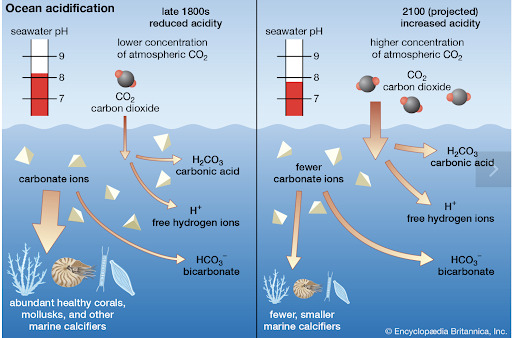
Figure 7. The process of ocean acidification. (Rafferty, John P. “Ocean Acidification.” Encyclopedia Britannica. January 30, 2020. Accessed February 2, 2020. https://www.britannica.com/science/ocean-acidification)
Other major threats to aquatic biodiversity are coastal development, runoff of pollutants, overfishing, and invasive species. Freshwater systems are also incredibly important, providing many ecosystem and economic services similar to marine systems, but one major new service is the provision of drinking water, which is a huge issue, especially politically.
In order to sustain aquatic biodiversity, I believe we must control emissions of carbon dioxide to prevent further damage to coral reefs, reduce fishing subsidies, and pass more laws protecting aquatic environments, unlike the Trump administration’s action that I referenced last week that did the opposite. While scientists lead the way, citizens and lawmakers must follow closely behind.
Word Count: 1040
Question: Is it accurate to say that many people who don’t believe in climate change are simply under-educated in the natural sciences, or does the problem run deeper than that?
[1] Miller, G. Tyler. Living in the Environment. 19th ed. (Boston: Cengage Learning, 2018) 79.
[2] Miller, Living in the Environment, 114.
[3] Miller, Living in the Environment, 145.
0 notes
Photo

Helloo! I have only had this blog for a week but haven’t yet created an introductory post so here goes,
- I started this studyblr to help motivate myself to study more; it’s so great that everyone on here is so motivated and dedicated to sharing study tips/tricks- i love it!
- I am in my final year of school doing my a-levels (politics, geography and english pre u) and am not sure if i want to take a year out or not but i have a uni place at kings college london to study international relations (woop)
- im 18 & i have always lived in london but, i went to 2 different boarding schools from the ages of 11-16 then moved home to study my last 2 years
- i have developed a minor-ish stationary addiction over the past month or so, i just can’t stop buying pens, notebooks and cute post its! (clock the sushi ones in the photo, they have tiny faces on them)
- i also love plants, i have 7 cacti in my room and my lovely big succulent you can see in the photo of my desk above
Here are a few of the many blogs i lovee and inspired me to make this studyblr:
@studypetals @peachi-study @studyplants @studywithinspo @academla @miaa-kale @lycheestudy @fuckstudy @minimaliststudy @studiette @lou-does-things @nauciti @legallychic @studyace @aescademic @areistotle @delthenerd @mildlincrs @study-harder @nahstudies @mochi-studies
& many more ! Elsa x
#elsastudies#studyblr#studyplants#studypetals#new studyblr#introductory post#studyspo#muji#studyaesthetic#green
100 notes
·
View notes
Photo
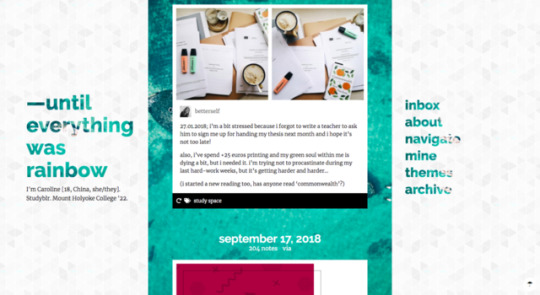
theme 03: lota by studyace
preview
code, alternate
contact me
up to 6 custom links, background image(s), 500px posts, responsive to most desktop screen sizes but not mobile friendly.
like/reblog if using!
222 notes
·
View notes